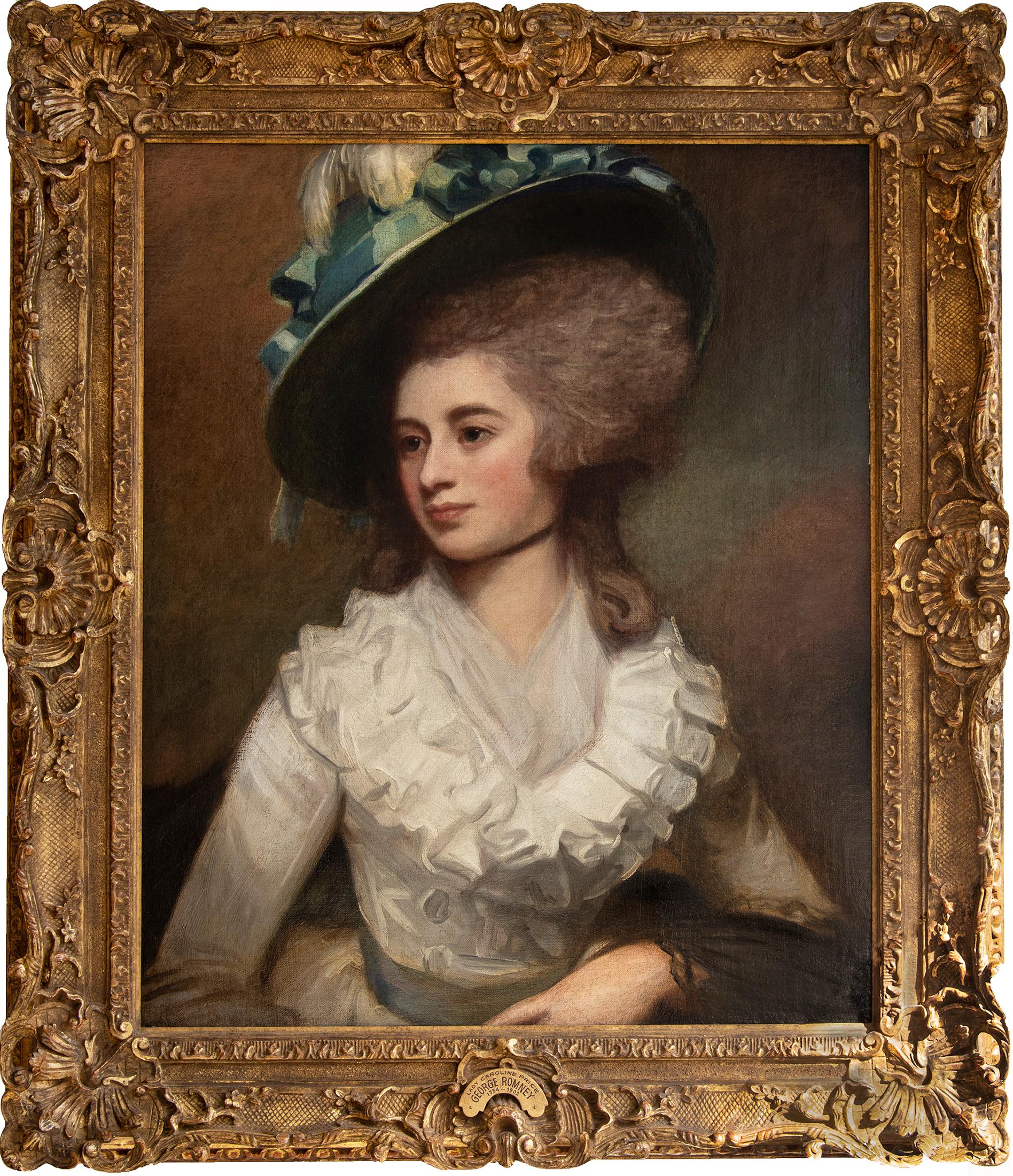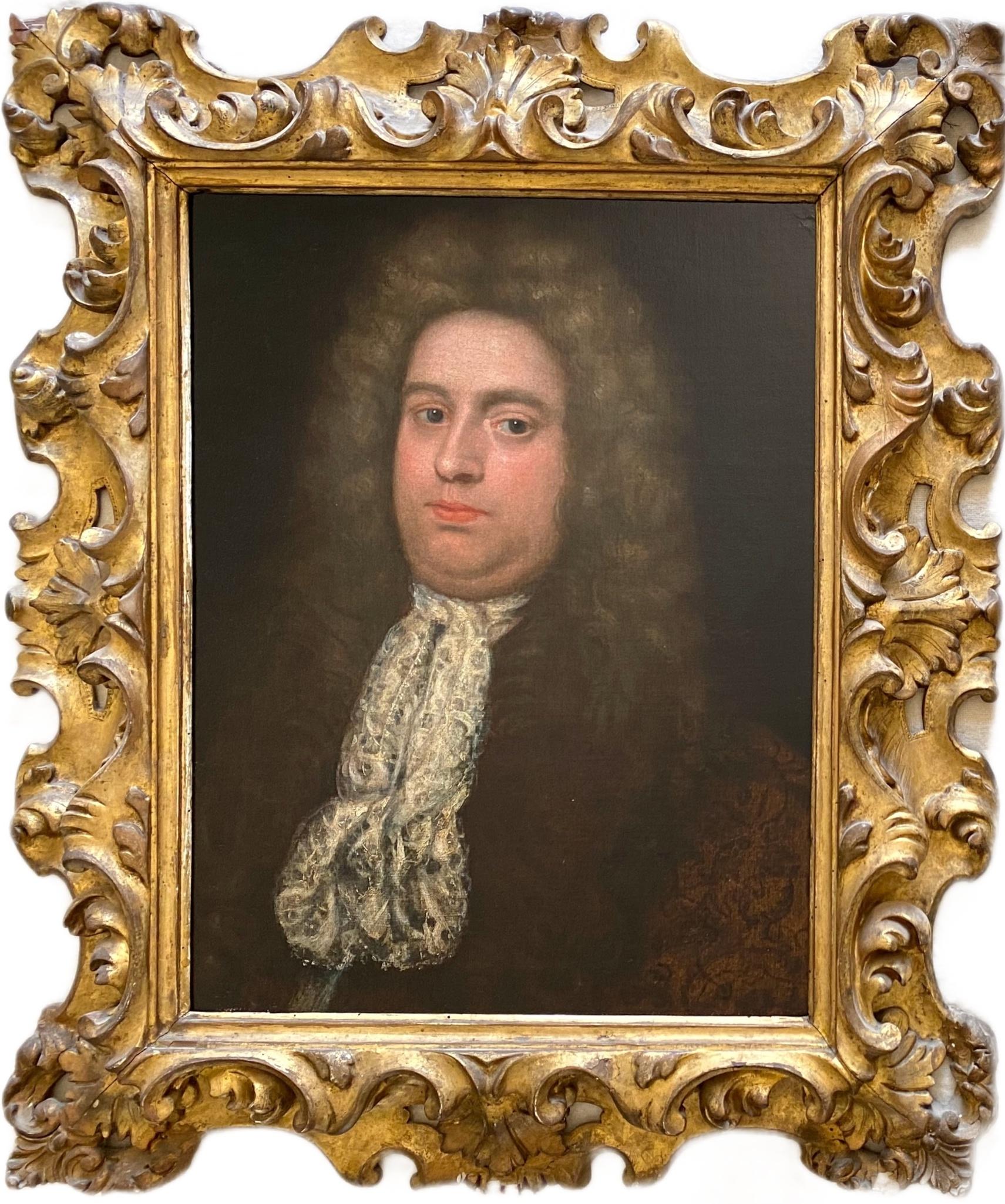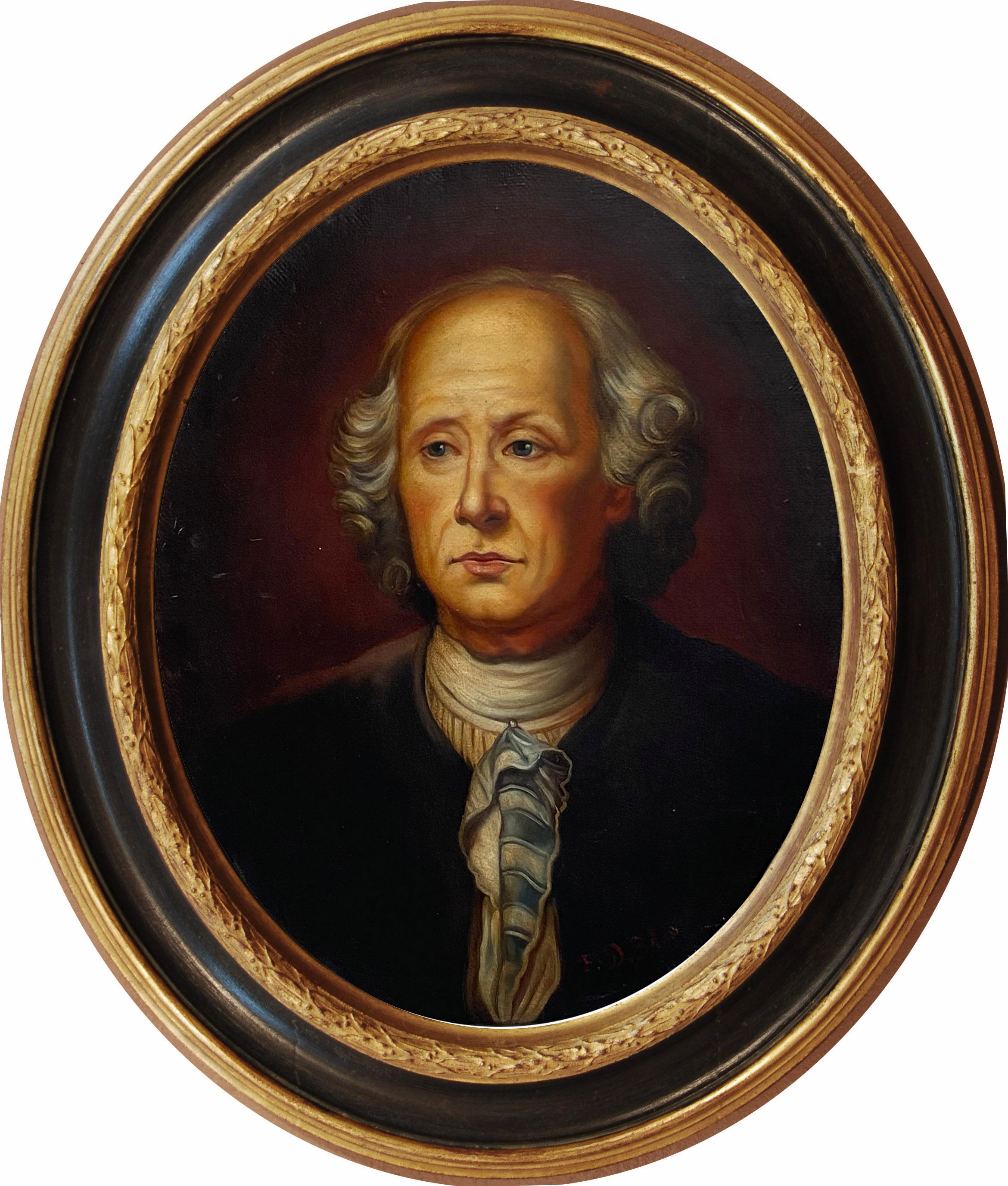Items Similar to A Portrait of a Bewigged Gentleman
Want more images or videos?
Request additional images or videos from the seller
1 of 8
A Portrait of a Bewigged Gentlemancirca 1720
circa 1720
About the Item
Enoch Seeman
Canvas Size: 30 x 25" (76 x 62cm)
Outside Frame Size: 37 x 32" (92 x 80cm)
1694-1744
He was born in Danzig, now Gdansk, Poland, around 1694. His father, also Enoch was born around 1661, and the Seeman family were painters.
Having been brought to London from his home of Flanders by his father in 1704, the younger Seeman's painting career as we know it began with a group portrait of the Bisset family in the style of the portraitist Godfrey Kneller, now held at Castle Forbes in Grampion Scotland, and dated by an inscription 1708.
As a painter to the British royal court Seeman the Younger completed portraits of George 1, in 1730, in the robes of his coronation and of George II some years later. The first of these pictures is held at the Middle Temple in London, England, and the second is at Windsor Castle in Berkshire, England, part of the royal collection.
In 1734, Seeman painted a portrait of Jane Pratt Taylor, daughter of Lord Chief Justice John Pratt. The portrait was sent to William Byrd II of Westover, in Virginia, where it became part of the largest colonial portrait collection of the early eighteenth century. The painting is now part of the collection of the Virginia Historical Society.
The Yale University Art Gallery owns a portrait of Elihu Yale in 1717 by Seeman and the Metropolitan Museum in New York, USA owns his rendering of Sir James Dashwood, described by the Grove Dictionary of Art as 'Exceptionally lively'. Also by Seeman the younger, Abraham Tucker in 1739 at the National Portrait Gallery in London, England, and various copies of sixteenth and seventeenth century portraits.
The National Trust owns two examples of this set of his work – at Dunham Massey in Cheshire, England, a copy of a portrait of Lady Diana Cecil, and at Belton House in Lincolnshire, England, of Lady Cust and her nine children. Dresden and Hanover museums have also displayed his work.
- Attributed to:Enoch Seeman (1694 - 1744, Polish)
- Creation Year:circa 1720
- Dimensions:Height: 37 in (93.98 cm)Width: 32 in (81.28 cm)Depth: 3 in (7.62 cm)
- Medium:
- Movement & Style:
- Period:
- Condition:There is slight natural craquelure as would be expected of a 300 year old beautiful painting. The frame is original to the painting and the piece was relined about 100 years ago.
- Gallery Location:St. Albans, GB
- Reference Number:1stDibs: LU2469214374752
About the Seller
5.0
Gold Seller
These expertly vetted sellers are highly rated and consistently exceed customer expectations.
Established in 1965
1stDibs seller since 2023
19 sales on 1stDibs
Typical response time: 1 hour
- ShippingRetrieving quote...Ships From: St. Albans, United Kingdom
- Return PolicyA return for this item may be initiated within 7 days of delivery.
More From This SellerView All
- Portrait of a Gentleman with his Dog - Possibly Abraham Tucker. Oil on CanvasBy Enoch SeemanLocated in St. Albans, GBEnoch Seeman - 1894 - 1744 An excellent example of Seeman's work. It is typically unsigned as was the case of many portraits of that time. A three quarter length portrait showing a r...Category
1730s Old Masters Portrait Paintings
MaterialsOil
- A Spanish LadyBy Charles BaxterLocated in St. Albans, GBA perfect example of Charles Baxter's work. A beautiful Spanish lady wearing typical Spanish attire. Despite being unsigned, the painting has full provenance having being fully catal...Category
Late 19th Century Victorian Figurative Paintings
MaterialsOil
- Portrait of a Lady possibly Frances Thynne, Lady Worsley 1673-1750 Oil on canvasBy Charles JervasLocated in St. Albans, GBCharles Jervas Possibly Frances Thynne, Lady Worsley 1673-1750 Oil on Canvas Picture Size: 50 x 40" Outside Frame Size: 58 x 48" 1675 – 1739 Charles Jervas, who was born in Clonli...Category
Early 1700s English School Portrait Paintings
MaterialsOil
- Portrait of a Man possibly Arthur Viscount Irwin, Temple Newsam Oil on canvasBy Charles JervasLocated in St. Albans, GBCharles Jervas Possibly Arthur, 6th Viscount Irwin (Temple Newsam) Oil on Canvas Picture Size: 50 x 40" Outside Frame Size: 58 x 48" 1675 – 1739 Charles Jervas, who was born in Cl...Category
Early 1700s English School Portrait Paintings
MaterialsOil
- A Pre-Raphaelite BeautyLocated in St. Albans, GBA wonderful painting of a beautiful woman in the style of the Pre-Raphaelites. It is signed Arnhold. It is in very condition and in the original frame. Picture Size: 21 x 21" (51 ...Category
1850s Pre-Raphaelite Portrait Paintings
MaterialsOil
- The Flower GirlBy Louise AbbemaLocated in St. Albans, GBLouise Abbéma 1853–1927 Louise Abbéma (30 October 1853[1] – 10 July 1927) was a French painter, sculptor, and designer of the Belle Époque. Abbéma was born in Étampes, Essonne Born into a wealthy aristocratic Parisian family with close ties to the city’s artistic community, She began painting in her early teens, and studied under such notables of the period as Charles Joshua Chaplin, Jean-Jacques Henner and Carolus-Duran. Portraits of actors and actresses at the Comédie Française dominated her early works until she made a name for herself at the Salon of 1876 with her portrayal of the “Divine Sarah.” Abbéma ultimately executed multiple portraits and received recognition for her work at age 23 a bronze medallion of Sarah Bernhardt, with whom she was a close friend and possibly lover. Like most women artists of the time, Abbéma focused mainly on portraiture and genre scenes (images of everyday life). Her high-society portraits executed with a light touch and rapid brushstrokes reveal the academic and Impressionist influences that shaped her style. Her sitters included French diplomats and other notable members of society. Abbéma developed a variety of techniques using oil paints, pastel, and watercolor, and worked on various supports, including fans. Abbéma received commissions for panels and murals which adorned the Paris Town Hall, the Paris Opera House, numerous theatres including the Theatre Sarah Bernhardt, and the "Palace of the Colonial Governor" at Dakar, Senegal. Abbéma solidified her international reputation after exhibiting works, including two wall murals (on canvas), at the Women’s Building at the 1893 World’s Columbian Exposition in Chicago. A bust of Sarah Bernhardt sculpted by Abbéma was also exhibited at the exposition. Abbéma specialized in oil portraits and watercolors, and many of her works showed the influence from Chinese and Japanese painters, as well as contemporary masters such as Édouard Manet. She frequently depicted flowers in her works. Among her best-known works are The Seasons, April Morning, Place de la Concorde, Among the Flowers, Winter, and portraits of actress Jeanne Samary, Emperor Dom Pedro...Category
1890s Impressionist Figurative Paintings
MaterialsOil
You May Also Like
- 18th Century Oil Painting Portrait of Provost John Pitcairn of DundeeBy Sir Henry RaeburnLocated in London, GBThe pendant to the present portrait showing John Pitcairn's wife Jean, née Robertson, is in the Huntington Art Gallery, San Marino. Both works are datable to the 1790s. Pitcairn, who served as Provost of Dundee from 1782-84, a position his father-in-law also held from 1731-32, later sat to Raeburn for another portrait, dated to circa 1820, which is now in the Royal Scottish Academy, Edinburgh Sale of Christie's London: Wednesday, July 9, 2014 [Lot 00212] Old Master & British Paintings Day Sale Sold For 22,500 GBP Premium Provenance By descent from the sitter to his great-grandson, Ronald Andrew Pitcairn of Pitcullo; Christie's, London, 25 June 1904, lot 58 (200 gns. to Wallis). Alexander Reid, Glasgow. With Agnew's, London, where acquired by A.R. Wilson Wood, 7 April 1909; Christie's, London, 26 June 1914, lot 78 (850 gns. to Agnew). Anonymous sale; Christie's, London, 24 November 1972, lot 27 (320 gns.) Private collection, Dublin, Ireland Exhibition Edinburgh, Royal Scottish Academy, 1876, no. 256 Literature W. Armstrong, Sir Henry Raeburn, London, 1901, p. 110. J. Greig, Sir Henry Raeburn, R.A., His life and work with a catalogue of his pictures, London, 1911, p. 55. R. Asleson and S.M. Bennett, British Paintings at The Huntington, New Haven and London, 2001, p. 312, fig. 12 Sir Henry Raeburn FRSE RA RSA (4 March 1756 – 8 July 1823) was a Scottish portrait painter and Scotland's first significant portrait painter since the Union to remain based in Scotland. He served as Portrait Painter to King George IV in Scotland. Raeburn was born the son of a manufacturer in Stockbridge, on the Water of Leith: a former village now within the city of Edinburgh. He had an older brother, born in 1744, called William Raeburn. His ancestors were believed to have been soldiers, and may have taken the name "Raeburn" from a hill farm in Annandale, held by Sir Walter Scott's family. Orphaned, he was supported by William and placed in Heriot's Hospital, where he received an education. At the age of fifteen he was apprenticed to the goldsmith James Gilliland of Edinburgh, and various pieces of jewellery, mourning rings and the like, adorned with minute drawings on ivory by his hand, still exist. Soon he took to the production of carefully finished portrait miniatures; meeting with success and patronage, he extended his practice to oil painting, at which he was self-taught. Gilliland watched the progress of his pupil with interest, and introduced him to David Martin, who had been the favourite assistant of Allan Ramsay the Latter, and was now the leading portrait painter in Edinburgh. Raeburn was especially aided by the loan of portraits to copy. Soon he had gained sufficient skill to make him decide to devote himself exclusively to painting. George Chalmers (1776; Dunfermline Town Hall) is his earliest known portrait. In his early twenties, Raeburn was asked to paint the portrait of a young lady he had noticed when he was sketching from nature in the fields. Ann was the daughter of Peter Edgar of Bridgelands, and widow of Count James Leslie of Deanhaugh. Fascinated by the handsome and intellectual young artist, she became his wife within a month, bringing him an ample fortune. The acquisition of wealth did not affect his enthusiasm or his industry, but spurred him on to acquire a thorough knowledge of his craft. It was usual for artists to visit Italy, and Raeburn set off with his wife. In London he was kindly received by Sir Joshua Reynolds, the president of the Royal Academy, who advised him on what to study in Rome, especially recommending the works of Michelangelo, and gave Raeburn letters of introduction for Italy. In Rome he met his fellow Scot Gavin Hamilton, Pompeo Girolamo Batoni and Byers, an antique dealer whose advice proved particularly useful, especially the recommendation that "he should never copy an object from memory, but, from the principal figure to the minutest accessory, have it placed before him." After two years of study in Italy he returned to Edinburgh in 1787, and began a successful career as a portrait painter. In that year he executed a seated portrait of the second Lord President Dundas. Examples of his earlier portraiture include a bust of Mrs Johnstone of Baldovie and a three-quarter-length of Dr James Hutton...Category
18th Century Old Masters Figurative Paintings
MaterialsOil
- Head of an AngelLocated in New York, NYProcaccini was born in Bologna, but his family moved to Milan when the artist was eleven years old. His artistic education was evidently familial— from his father Ercole and his elder brothers Camillo and Carlo Antonio, all painters—but his career began as a sculptor, and at an early age: his first known commission, a sculpted saint for the Duomo of Milan, came when he was only seventeen years old. Procaccini’s earliest documented painting, the Pietà for the Church of Santa Maria presso San Celso in Milan, was completed by 1604. By this time the artist had made the trip to Parma recorded by his biographers, where he studied Correggio, Mazzola Bedoli, and especially Parmigianino; reflections of their work are apparent throughout Procaccini's career. As Dr. Hugh Brigstocke has recently indicated, the present oil sketch is preparatory for the figure of the angel seen between the heads of the Virgin and St. Charles Borrommeo in Procaccini's altarpiece in the Church of Santa Afra in Brescia (ill. in Il Seicento Lombardo; Catalogo dei dipinti e delle sculture, exh. cat. Milan 1973, no. 98, pl. 113). As such it is the only known oil sketch of Procaccini's that can be directly connected with an extant altarpiece. The finished canvas, The Virgin and Child with Saints Charles Borrommeo and Latino with Angels, remains in the church for which it was painted; it is one of the most significant works of Procaccini's maturity and is generally dated after the artist's trip to Genoa in 1618. The Head of an Angel is an immediate study, no doubt taken from life, but one stylistically suffused with strong echoes of Correggio and Leonardo. Luigi Lanzi, writing of the completed altarpiece in 1796, specifically commented on Procaccini's indebtedness to Correggio (as well as the expressions of the angels) here: “Di Giulio Cesare...Category
17th Century Old Masters Figurative Paintings
MaterialsPaper, Canvas, Oil
- 17th Century by Giuseppe Assereto Portrait of an Elderly Woman Oil on CanvasBy Giuseppe AsseretoLocated in Milano, LombardiaGiuseppe Assereto (Genova - 1626 ca – Genova 1656/57) Portrait of an elderly woman, possible portrait of Maddalena Massone, wife of Gioacchino Assereto Oil on canvas, cm. 65,5 x 51,5...Category
Early 17th Century Old Masters Portrait Paintings
MaterialsCanvas, Oil
- Portrait of Lady Caroline PriceBy George RomneyLocated in Miami, FLDESCRIPTION: Perhaps the best Romney in private hands. If Vogue Magazine existed in the late 18th century, this image of Lady Caroline Price would be ...Category
1970s Old Masters Portrait Paintings
MaterialsCanvas, Oil
- 17th Century English Portrait of Admiral Horatio Nelson's great grandfatherLocated in Norwich, GBA fascinating portrait dating from circa 1695-1700 with wonderful provenance: it belonged to the British industrialist Leonard Pelham Lee (1903–1980) and hung in his manor house in W...Category
17th Century Old Masters Portrait Paintings
MaterialsOil, Canvas
- PORTRAIT OF A GENTLMEN - French School -Portrait Italian Oil on Canvas PaintingBy Eugenio De BlasiLocated in Napoli, ITPortrait of a Gentlemen - Oval oil on canvas cm.50x40, Italia, 2006 Eugenio De Blasi Wooden frame available on request The portrait of Eugenio De Blasi is inspired by one of the many portraits painted by Guillam Francois Colson, a French historian painter, who painted portraits of families...Category
Early 2000s Old Masters Portrait Paintings
MaterialsCanvas, Oil





